在巴黎氣候大會上,法國總統歐蘭德與聯合國秘書長潘基文一同宣布,法國將在2016年至2020年間挹注21億美元於非洲發展再生能源,比過去五年增加50%。
聯合國氣候大會開幕當日,各國領導人齊聚巴黎。圖片來源:COPPARIS2015。
非洲挑戰峰會 法國資助再生能源發展
在非洲挑戰(African Solutions)峰會上,召集了12個非洲國家的領導人、非洲聯盟委員會主席、多位政府代表以及世界銀行、非洲發展銀行等國際機構代表參與。
這些資金將依各國情況鼓勵太陽能、風力、水力或地熱能的使用。法國資助的計畫將成為非洲聯盟再生能源計畫的一部分。
科技業領袖組能源聯盟 研發預算有著落
11月30日,24位高科技領袖組成突破能源聯盟(Breakthrough Energy Coalition),目的在推展乾淨能源的創新和來自公民社會的氣候解決方案。
與會者包括微軟創辦人比爾蓋茲、臉書創辦人馬克祖克柏、亞馬遜創辦人傑夫貝佐斯、阿里巴巴創辦人馬雲及維京集團創辦人李察布蘭森等。比爾蓋茲一人就將出資20億美元於突破能源聯盟。
這些投資人將與組成「創新任務」的20個國家合作,發展新乾淨能源科技。這20國皆承諾在接下來5年間加倍乾淨能源的研發預算。
GEF環境基金獲挹注 最脆弱國家也有保障
30日的另一個會議上,加拿大、丹麥、芬蘭、法國、德國等11個出資國宣示投入2億5千萬美元於全球環境基金主持(Global Environment Facility, GEF)的「落後國家資金」(Least Developed Countries Fund),幫助世界上最脆弱的國家發展氣候適應能力。德國是其中出資最多的國家,貢獻5千萬歐元(5千3百萬美金)。第二名是美國,出資5千1百萬美元。
這筆資金將讓GEF得以回應許多既有的需求,包括投資氣候適應的新農法和建立氣候變遷與災難的適應能力。
歐盟轉型基金 鼓勵開發中國家減碳
同一日,德國、挪威、瑞典和瑞士四個歐盟國家宣布新的5億美金計畫「轉型碳資產基金」(轉型碳資產基金),尋找開發中國家大規模減碳的新獎勵方案。
「轉型碳資產基金」將幫助開發中國家減碳同時創造新的碳資產,測量和支付大規模的氣候計畫,包括再生能源、運輸、能源效率、固態廢棄物管理和低碳城市等,為開發中國家支付淘汰化石燃料補助或簡化再生能源管理產生的成本。
「轉型碳資產基金」將於2016年開始運作,首筆來自出資國的資金超過2億5千萬美元。該基金將保持開放,直到5億美元的目標達成。
France will invest a total of €2 billion (US$2.1 billion) in renewable energy in Africa in 2016-20, a 50 percent increase in comparison with the past five years.
French President François Hollande made the announcement today alongside UN Secretary-General Ban Ki-moon at the Climate Challenge, African Solutions summit at the COP 21 climate change conference in Paris.
Programs will encourage the use of solar energy, wind power, hydroelectricity or geothermal energy, depending on the potential of each country. Projects financed by France will be able to register as part of the initiative on renewable energy led by the African Union.
The summit gathered 12 African heads of state, the President of the Commission of the African Union and representatives of several governments as well as international institutions such as the World Bank and the African Development Bank.
At another event, held on Monday, some two dozen high-tech leaders launched the Breakthrough Energy Coalition, which aims to revolutionize the generation of clean energy, giving a boost to civil society’s climate solutions.
Among the billionaire founders are Microsoft’s Bill Gates, Facebook’s Mark Zuckerberg, Amazon.com’s Jeff Bezos, Alibaba Group’s Jack Ma, Virgin’s Richard Branson and George Soros of the Soros Fund.
Gates alone will contribute US$2 billion to the new coalition.
The investors will work with 20 countries who have formed Mission Innovation to explore new clean energy technologies. Each of the 20 nations has promised to double its clean energy R&D budget over the next five years.
In a separate effort announced on Monday, 11 donor nations pledged close to US$250 million in new money for adaptation support to the most vulnerable countries on the planet.
Canada, Denmark, Finland, France, Germany, Ireland, Italy, Sweden, Switzerland, United Kingdom, and the United States announced their contributions to the Least Developed Countries Fund, a climate fund hosted by the Global Environment Facility, GEF.
Germany is the top contributor with a total amount of 50 million Euros (US$53 million). The United States came second with a contribution of $51 million.
The new financing will enable the GEF to respond to the many existing requests for support ranging from investments in new approaches to agriculture to national adaptation planning and building resilience against climate change variability and disasters.
In a separate set of pledges Monday, four European countries – Germany, Norway, Sweden, and Switzerland – announced a new $500 million initiative – Transformative Carbon Asset Facility – that will find new ways to create incentives aimed at large scale cuts in greenhouse gas emissions in developing countries.
The Transformative Carbon Asset Facility will help developing countries implement their plans to cut emissions by working with them to create new classes of carbon assets associated with reduced greenhouse gas emission reductions.
The facility will measure and pay for emission cuts in large scale programs in areas like renewable energy, transport, energy efficiency, solid waste management, and low carbon cities. It could make payments for emission reductions to countries that remove fossil fuel subsidies or simplifying regulations for renewable energy.
This Transformative Carbon Asset Facility will start operations in 2016 with an initial expected commitment of more than $250 million from contributing countries. The facility will remain open for more contributions until a target of $500 million is reached.
※ 全文及圖片詳見:ENS









